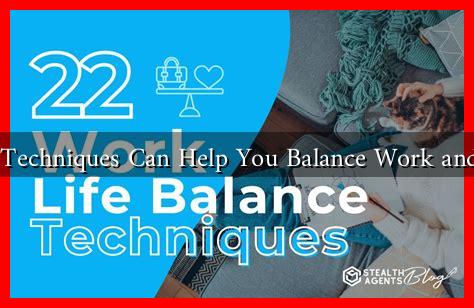-
Table of Contents
What Techniques Can Help You Balance Work and Life?
In today’s fast-paced world, achieving a balance between work and personal life can feel like an elusive goal. With the rise of remote work and the constant connectivity provided by technology, the lines between professional and personal time have blurred. However, implementing effective techniques can help individuals reclaim their time and enhance their overall well-being. This article explores various strategies to help you achieve a harmonious work-life balance.
Understanding Work-Life Balance
Work-life balance refers to the equilibrium between the time and energy devoted to work and personal life. A healthy balance is crucial for mental health, productivity, and overall satisfaction. According to a survey by the American Psychological Association, 60% of employees reported that work-related stress negatively impacted their personal lives. Therefore, finding ways to manage this stress is essential.
Effective Techniques for Balancing Work and Life
1. Set Clear Boundaries
Establishing boundaries between work and personal time is vital. Here are some ways to do this:
- Designate Work Hours: Set specific hours for work and stick to them. Communicate these hours to your colleagues and family.
- Create a Dedicated Workspace: If working from home, have a designated area for work to mentally separate it from personal space.
- Limit After-Hours Communication: Avoid checking emails or messages after work hours to prevent work from encroaching on personal time.
2. Prioritize Tasks Effectively
Using prioritization techniques can help manage workload and reduce stress. Consider the following methods:
- The Eisenhower Matrix: Categorize tasks into four quadrants based on urgency and importance to focus on what truly matters.
- Time Blocking: Allocate specific blocks of time for different tasks, ensuring that personal activities are also scheduled.
- Daily To-Do Lists: Create a list of tasks each day, focusing on completing the most important ones first.
3. Embrace Flexibility
Flexibility in work arrangements can significantly enhance work-life balance. Here are some options:
- Remote Work: If possible, negotiate remote work options to save commuting time and create a more comfortable work environment.
- Flexible Hours: Discuss with your employer the possibility of flexible working hours that accommodate personal commitments.
- Job Sharing: Consider sharing responsibilities with a colleague to reduce workload while maintaining productivity.
4. Practice Self-Care
Taking care of your physical and mental health is crucial for maintaining balance. Incorporate self-care practices into your routine:
- Regular Exercise: Engage in physical activities that you enjoy, as exercise is proven to reduce stress and improve mood.
- Meditation and Mindfulness: Practice mindfulness techniques to stay present and reduce anxiety.
- Quality Time with Loved Ones: Make time for family and friends to strengthen relationships and provide emotional support.
Case Studies and Statistics
Research supports the importance of work-life balance. A study by the Global Workplace Analytics found that remote work can increase productivity by 35-40%. Additionally, companies that promote work-life balance see a 25% reduction in employee turnover. For instance, companies like Google and Microsoft have implemented flexible work policies, resulting in higher employee satisfaction and retention rates.
Conclusion
Achieving a work-life balance is not just a personal goal; it is essential for overall well-being and productivity. By setting clear boundaries, prioritizing tasks, embracing flexibility, and practicing self-care, individuals can create a more harmonious life. Remember, balance is not a one-time achievement but an ongoing process that requires regular adjustments. As you implement these techniques, you will likely find that both your professional and personal life flourish.
For more insights on work-life balance, consider visiting American Psychological Association.


